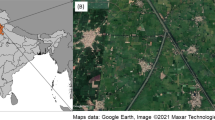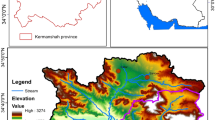Abstract
Symmetrical relationships between humans and their environment have been referred to as an extension of symmetries in the human geographical system and have drawn great attention. This paper explored the symmetry between physical and human systems through fractal analysis of the road and drainage networks in Wuling mountainous area. We found that both the road and drainage networks reflect weak clustering distributions. The evolution of the road network shared a significant self-organizing composition, while the drainage network showed obvious double fractal characteristics. The geometric fractal dimension of the road network was larger than that of the drainage network. In addition, when assigned a weight relating to hierarchy or length, neither the road network nor drainage network showed a fractal property. These findings indicated that the fractal evolution of the road network shared certain similarities with fractal distribution of the drainage network. The symmetry between the two systems resulted from an interactive process of destroying symmetry at the lower order and reconstructing symmetry at the higher order. The relationships between the fractal dimensions of the rural-urban road network, the drainage network and the urban system indicated that the development of this area was to achieve the symmetrical isomorphism of physical-human geographical systems.
Similar content being viewed by others
References
Mandelbrot BB (1967) How long is the coast of Britain? Statistical self-similarity and fractional dimension. Science 156(3775): 636–638.
Mandelbrot BB (1977) Fractals: Form, Chance, and Dimension. San Francisco, U. S. Freeman. pp 121–142.
Tarboton DG, Bras RL, Rodriguez-Iturbe I (1988) The fractal nature of river networks. River Resources Research 24(8):1317–1322. DOI: 10.1029/WR024i008p01317.
Rosso R, Bacchi B, La Barbera P (1991) Fractal relation of mainstream length to catchment area in river networks. River Resources Research 27(3): 381–387. DOI: 10.1029/90WR02404.
Zhu XH, Cai YL (2003) On box dimensions of river basins of China. Advances in River Science 14(6): 731–735. (In Chinese)
Bai CG, Cai XH (2008) Fractal characteristics of transportation network of Nanjing city. Geographic Research 27(6):1419–1425. (In Chinese)
Feng YJ, Liu ML, Tong XH (2008) Fractal theory based study on highway transportation networks in Guangdong Province. Geo-Information Science 10(1): 26–33. (In Chinese)
Liu J, Zhen C, Zhang WH, et al. (2012) On fractals and fractal dimensions of local river system in hilly area of Sichuan Basin. Journal of Southwest University (Natural Science Edition) 34(3): 76–82. (In Chinese)
Gao S, Zhang J (2006) Modern Geography. High Education Press. Beijing, China. pp 63–79. (In Chinese)
Wang B, Tian FQ, Hu HP (2009) Relationship between fractal dimension of river networks and their climates. Journal of Tsinghua University (Science and Technology) 49(12): 1948–1953. (In Chinese)
Chen YG (2008) Fractal Urban System: Scaling, Symmetry and Spatial Complexity. Science Press, Beijing, China. pp 331. (In Chinese)
Liu JS, Chen YG (2003) Multi-fractal measures based on human-environment relationships of the spatial structure of the urban system in Henan. Scientia Geographica Sinica 23(6): 713–720. (In Chinese)
Chen YG, Liu JS (2001) Studies of analogies of fractal structure between river networks and system of central places: a theoretical approach to the symmetry between physical and human geographical system. Progress in Geography 20(1): 81–88. (In Chinese)
Ye DN (2000) Geography and Symmetry. Shanghai Science and Technology Education Press, Shanghai, China. p 3. (In Chinese)
Ye DN, Hao W, Xu WD, et al. (2001) Symmetrical distribution of Chinese cities. Science in China, Series D 31(7): 608–616. (In Chinese)
Chen YG (2009) New way of looking at human geographical laws using the idea from symmetry. Progress in Geography 28(2): 312–320. (In Chinese)
Barbera PL, Rosso R (1989) On the fractal dimension of stream networks. Water Resources Res 25(4): 735–741. DOI: 10.1029/WR025i004p00735.
Tarboton DG, Bras RL, Rodriguez-Iturbe I (1990) Comment on “On the fractal dimension of stream networks” by Paolo La Barbera and Renzo Rosso. Water Resources Res 26(9): 2243–2244. DOI: 10.1029/WR026i009p02243.
Chen YG, Liu JS (2001) Fractals and fractal dimensions of structure of river system: models reconstruction and parameters interpretation of Horton’s laws of network composition. Advance in Earth Sciences 16(2): 178–183. (In Chinese)
Chen YG, Li BL (2003) Studies of the fractal network composition of rivers in Jilin Province, China. Advance in Earth Sciences 18(2): 178–184. (In Chinese)
Long TW, Zhao JB (2008) A study on the fractal properties of a typical drainage basin on the loess plateau based on DEM. Earth and Environment 36(4): 304–308. (In Chinese)
Sun GK, Gong XL, Mo CX, et al. (2009) Study on the calculation method of fractal dimension of river system. River Power 35(10): 64–66. (In Chinese)
Frankhouser P (1990) Aspects fractals des structures urbaines. Espace géographique 19(1):45–69. DOI: 10.3406/spgeo.1990.2943. (In France)
Benguigui L, Daoud M (1991) Is the suburban railway system a fractal? Geographical Analysis 23: 362–368. DOI: 10.1111/j.1538-4632.1991.tb00245.x.
Chen YG, Luo J (1998) The fractal features of the transport network of Henan Province. Journal of Xinyang Teachers College (Natural Science Edition) 11(2): 172–177. (In Chinese)
Chen YG (1999) A new fractal dimension on transport networks and the method of its determination. Journal of Xinyang Normal University (Natural Science Edition) 12(4): 426–434. (In Chinese)
Chen YG, Liu JS (1999) The DBM features of transport networks of a district—a study on the Laplacian fractals of networks of communication lines. Scientia Geographica Sinica 19(2): 114–118. (In Chinese)
Liu JS, Chen YG (1999) A study on fractal dimensions of spatial structure of transport networks and the methods of their me termination. Acta Geographica Sinica 54(5): 471–478. (In Chinese)
Li XL, Li CG (2012) The application of the fractal theory on study of the transportation network in Jilin Province. Journal of Northeast Normal University (Natural Science Edition) 44(2): 138–142. (In Chinese)
Li YT, Pan SQ, Miao CH (2012) Study on fractal properties of highway transportation networks in Henan province based on GIS. Areal Research and Development 31(5): 148–153. (In Chinese)
Shen JH, Lu YQ, Lan XJ (2012) Relationship between the road network and regional economic development based on the fractal theory. Scientia Geographica Sinica 32(6): 658–665. (In Chinese)
Mandelbrot BB, Passoja DE, Paullay AJ (1984) Fractal character of fracture surfaces of metals. Nature 308: 721–722. DOI: 10.1038/308721a0.
Ogata Y, Katsura K (1991) Maximum likelihood estimates of the fractal dimension for random spatial patterns. Biometrika 78(3):463–474. DOI: 10.1093/biomet/78.3.463.
Taylor CC, Taylor SJ (1991) Estimating the dimension of a fractal. Journal of the Royal Statistical Society: Series B (Methodological) 53(2): 353–364. DOI: 0035-9246/91/53353.
Liu CL (2009) Space development mechanism and control strategy of Wuhan Metropolitan Area. Science Press, Beijing, China. pp 170–171. (In Chinese)
Tang GA, Yang X (2006) Spatial analysis experiments tutorial for Geographic Information System. Science Press, Beijing, China. p 442. (In Chinese)
Iversen GR, Gergen M (1997) Statistics: The Conceptual Approach. Springer, Springer-Verlag New York Inc.. p 753.
Batty M, Longley P (1994) Fractal Cities: a Geometry of Form and Function. Academic Press, London, Harcourt Brace & Company Publishers.
Author information
Authors and Affiliations
Corresponding authors
Rights and permissions
About this article
Cite this article
Liu, Cl., Duan, Dz. & Zhang, H. Relationships between fractal road and drainage networks in Wuling mountainous area: Another symmetric understanding of human-environment relations. J. Mt. Sci. 11, 1060–1069 (2014). https://doi.org/10.1007/s11629-013-2705-6
Received:
Accepted:
Published:
Issue Date:
DOI: https://doi.org/10.1007/s11629-013-2705-6




